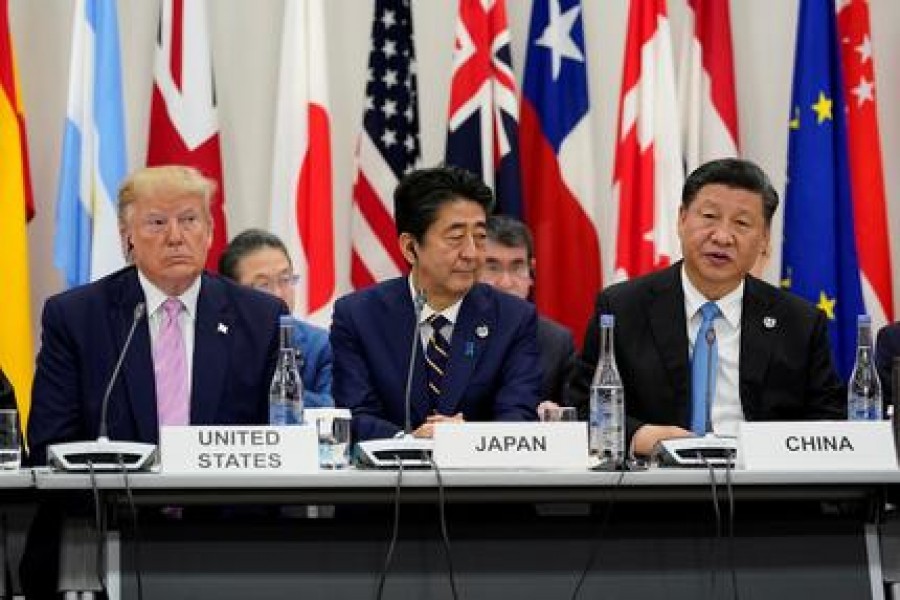With a good deal of its rule-based system not adhered to by mighty economies and the vision of multilateralism going off-track, the World Trade Organisation (WTO) after more than a decade of its inception looks more like a monitoring body than what it was meant to be - the key global instrument for ensuring coherence and order in international trade through mitigating asymmetries among global trading patterns and practices.
This has been starkly revealed in the recent Trade Monitoring Report of the WTO that shows that the world's most powerful bloc comprising the G20 countries are increasingly pursuing trade-restrictive measures at the expense of the poorer nations to solidify their protectionist regimes. The report shows that the stock of restrictive trade measures introduced by G20 economies since 2008 continues to rise despite the pledge to roll back new protectionist measures that may have arisen.
The WTO's new Trade Monitoring Report issued last month shows that G20 economies from mid-May to mid-October 2019 introduced import-restrictive measures covering an estimated USD 460.40 billion worth of traded merchandise. This represents a 37 per cent increase over the previous period going back to mid-October 2018. The report notes that with restrictions accumulating over time, the share of global trade covered by such measures has soared.
In view of the continuing uncertainties in global economy, the report stresses the need for countries to show restraint to imposing new measures and additionally eliminate more of the existing measures. WTO Director-General Roberto Azevêdo called on G20 economies to de-escalate trade tensions to spur investment, growth and job creation.
G20, a mighty coalition of the most developed and advanced developing economies (with the only exception of Russia), is by all means the most decisive factor not only in matters of trade but in other areas of the world order as well. So, when the WTO secretariat's report termed G20 trade practices restrictive, it clearly implied that beside the harms such practices bring for the rest of the world, these also constitute a well-devised protectionist agenda.
Commenting on the report, Director-General Roberto Azevêdo said, "The report's findings should be of serious concern for G20 governments and the broader international community. Historically high levels of trade-restrictive measures are having a clear impact on growth, job creation and purchasing power around the world. We need to see strong leadership from G20 economies if we want to avoid increased uncertainty, lower investment and even weaker trade growth. We have seen how world trade has stalled during the review period. The WTO downgraded its forecast for merchandise trade growth in 2019 to 1.2 per cent, the slowest since the crisis a decade ago. New trade restrictions and increasing trade tensions will only add to the uncertainty that is dragging down growth in the world economy."
The report indicates that the slowdown in world trade growth coincided with increasingly negative indicators for world trade and output.
In terms of numbers, G20 economies implemented 28 new trade-restrictive measures between mid-mid-May and mid-October 2019 -- mainly tariff increases, import bans and stricter customs procedures for imports. In addition, many import restrictions implemented since 2009 are still in force, resulting in a growing stockpile of measures that in 2018 affected 8.8 per cent of G20 imports (USD 1.3 trillion). The trade coverage of import-restrictive measures in force for the period January-October 2019 is estimated at USD 1.6 trillion, suggesting that import restrictions have continued to grow.
During the review period, the monthly average of trade remedy actions initiated by G20 economies was the highest registered since 2012, and more than double the average recorded in the previous G20 Report. Initiations of anti-dumping investigations continue to be the most frequent trade remedy action, accounting for more than four-fifths of all initiations. Meanwhile, the monthly average of trade remedy terminations recorded was the second-lowest since 2012. The trade coverage of trade remedy initiations recorded in this report was estimated at USD 16.7 billion and that of terminations at USD 3.8 billion.
It is often alleged that the G20 economies suffer from a serious lack of transparency as regards what is termed 'behind-the-border measures'. These behind-the-border measures include regulatory measures and subsidies. Non-tariff measures, the key constituent of the regulatory measures applied by a number of G20 economies have been the subject of debate in various WTO bodies. Some consider that these types of measures have become more prominent in recent years, compared to conventional border measures.
What is stated above is mostly reproduced from the monitoring report. By flouting the WTO rules and backtracking from their own commitments many a time, especially those made at the Brisbane Summit in 2014, the G20 economies clearly demonstrate a stance that refuses to yield to the nuances of equity and level playing norms of globalisation, and indeed the much touted multilateralism.
The fallout makes many developing countries confused as to the outcome of the progress they may have made in harmonising their trade regimes and trading practices with those of their stronger trade partners -- who happen to be members of the G20. The difficult, at times near-impossible, task is that these countries have to continually adjust to the evolving trade practices of their G20 counterparts that are largely trade-restrictive in nature - either in the form of non-tariff measures or compliance needs.
Under the circumstances, isn't it time that the role of the WTO needed to be redefined - to be more binding in so far as asking the members to follow the rule-based system of the global body.


